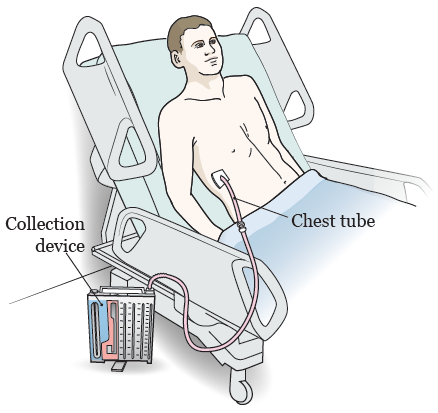This information describes what to expect when you have a chest tube placed. This procedure can be done if you’re having trouble breathing because extra air, extra fluid, or both is built up around one of your lungs.
A chest tube is a flexible tube that’s placed between your ribs, into your pleural space. Your plural space is the space between the inner and outer linings of your lungs. The chest tube will drain extra air, extra fluid, or both from your pleural space into a collection device (large plastic container) (see Figure 1).

Figure 1. Chest tube and collection device
About Your Placement Procedure
This procedure is usually done in your hospital room while you’re in your bed. Your healthcare provider will keep track of your vital signs (heart rate, blood pressure, temperature, and breathing rate) and oxygen levels during your procedure.
First, you’ll have an ultrasound scan while you’re in bed. This is an imaging scan that uses sound waves to create pictures of the inside of your body. Your healthcare provider will use the scan to see exactly where to place the chest tube. When the right place is found, you’ll get an injection of local anesthetic in that area. A local anesthetic is a medication that makes an area of your body numb.
After the area is numb, your healthcare provider will make a small incision (surgical cut). They’ll place the chest tube into the incision, between your ribs, and into your pleural space. You may feel some pressure when they’re placing the tube. If you feel any discomfort during your procedure, tell your healthcare provider.
Once the chest tube is placed, your healthcare provider will stitch it in place to keep it from moving. They’ll cover the area with a bandage. Then you’ll have a chest x-ray while you’re in bed. Your healthcare provider will use the x-ray to see the chest tube and make sure it’s in the right place.
While You Have Your Chest Tube
You may feel some discomfort or pain once the local anesthetic wears off. If you do, tell your healthcare provider. They’ll check your chest tube and give you pain medication as needed.
Your healthcare provider will keep track of how much air, fluid, or both is coming from your chest tube during your hospital stay. You’ll also have chest x-rays to check how well your tube is working.
Caring for your chest tube
It’s important that your chest tube doesn’t twist or bend so that it can drain the right way. Keep the collection device upright and below your chest (see Figure 1). This will help your tube to drain.
You can sit up, lay down, and walk around while you have your chest tube. Make sure you don’t pull on your tube when you move around or walk. Your healthcare provider will help you move around, if needed.
Take sponge baths while your chest tube is in place. Don’t shower. Keep the bandage clean and dry. Tell your healthcare provider if it gets wet, dirty, comes loose, or starts to lift from your skin.
Your chest tube will be taken out before you leave the hospital. Your healthcare provider will give you more information about when it will be taken out.
When to Use Your Call Bell to Get a Member of Your Care Team
Tell your healthcare provider if:
- You have shortness of breath (trouble breathing) that’s very bad or getting worse.
- You have pain on the side of your body where your chest tube is that’s very bad or getting worse.
- Your collection device falls over.